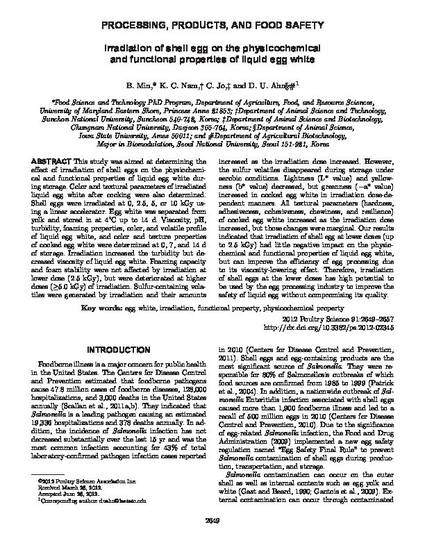
This study was aimed at determining the effect of irradiation of shell eggs on the physiochemical and functional properties of liquid egg white during storage. Color and textural parameters of irradiated liquid egg white after cooking were also determined. Shell eggs were irradiated at 0, 2.5, 5, or 10 kGy using a linear accelerator. Egg white was separated from yolk and stored in at 4°C up to 14 d. Viscosity, pH, turbidity, foaming properties, color, and volatile profile of liquid egg white, and color and texture properties of cooked egg white were determined at 0, 7, and 14 d of storage. Irradiation increased the turbidity but decreased viscosity of liquid egg white. Foaming capacity and foam stability were not affected by irradiation at lower dose (2.5 kGy), but were deteriorated at higher doses (≥5.0 kGy) of irradiation. Sulfur-containing volatiles were generated by irradiation and their amounts increased as the irradiation dose increased. However, the sulfur volatiles disappeared during storage under aerobic conditions. Lightness (L* value) and yellowness (b* value) decreased, but greenness (−a* value) increased in cooked egg white in irradiation dose-dependent manners. All textural parameters (hardness, adhesiveness, cohesiveness, chewiness, and resilience) of cooked egg white increased as the irradiation dose increased, but those changes were marginal. Our results indicated that irradiation of shell egg at lower doses (up to 2.5 kGy) had little negative impact on the physiochemical and functional properties of liquid egg white, but can improve the efficiency of egg processing due to its viscosity-lowering effect. Therefore, irradiation of shell eggs at the lower doses has high potential to be used by the egg processing industry to improve the safety of liquid egg without compromising its quality.
Available at: http://works.bepress.com/dong_ahn/133/

This article is published as Min, B., K. C. Nam, C. Jo, and D. U. Ahn. "Irradiation of shell egg on the physicochemical and functional properties of liquid egg white." Poultry science 91, no. 10 (2012): 2649-2657. doi:10.3382/ps.2012-02345.